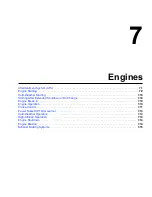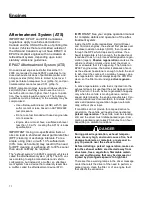
each 1000 feet (300 m) altitude above sea level for a
naturally aspirated engine.
All engines used on M2 vehicles are altitude-
compensated by the use of a turbocharger. This re-
duces smoky exhaust at high altitudes, requires less
downshifting, and allows the engine to make better
use of its fuel. Nevertheless, shift gears as needed to
avoid excessive exhaust smoke.
Engine Shutdown
1.
With the vehicle stopped, apply the parking
brakes and place the transmission in neutral.
NOTICE
Idle the engine one to two minutes before shut-
ting it down. After hard operation, shutting down
the engine without idling may cause damage to
the turbocharger.
2.
Allow the engine to idle one to two minutes be-
fore shutting it down. This allows the lubricating
oil and the coolant to carry heat away from the
combustion chambers, bearings, shafts, and
seals. The extreme heat may cause bearings to
seize or oil seals to leak.
IMPORTANT: Bearings and seals in the turbo-
charger are subjected to the high heat of com-
bustion exhaust gases. While the engine is run-
ning, this heat is carried away by oil circulation,
but if the engine is stopped suddenly, the turbo-
charger temperature may rise as much as 115°F
(46°C).
NOTICE
Except in an emergency, do not shut down the
engine when the coolant temperature is above
194°F (90°C). To do so could damage the engine.
3.
Turn off the ignition switch and shut down the
engine.
Engine Braking
The engine brake switch controls the degree of en-
gine braking. Normally there are two paddle
switches, a two-position On/Off Switch to activate the
engine brake, and a two-position HI-LO Switch to
control the amount of engine braking.
To turn the two-position On/Off Switch on, raise the
paddle. When the two-position switch is on, an
amber LED (light-emitting diode) illuminates inside
the switch.
To turn the two-position HI-LO Switch on high, raise
the paddle (at the HI-LO legend). To turn the two-
position HI-LO Switch on low, lower the paddle (at
the ENG BRK legend). See
Fig. 7.17
.
When the panel lights are on, the Hi-Lo legend is
backlit in amber on the three-position switch. On both
the three-position switch and the two-position switch,
the ENG BRK legend is backlit in green when the
panel lights are on.
Whenever vehicle braking is required on good road
conditions, the engine brake may be used in con-
junction with the service brakes. There is no time
limit for operation of the engine brake. However, an
engine brake does not provide the precise control
available from the service brakes, and is not a sub-
stitute for a service braking system.
WARNING
Usage of the engine brake as the primary braking
system can cause unpredictable stopping dis-
tances, that could result in personal injury or
property damage. Service brakes are the primary
vehicle braking system.
Since the engine brake is most effective at rated en-
gine speed, gear selection is very important. Gearing
down the vehicle, within the limits of the rated engine
10/17/2001
f610588
1
2
1.
On/Off Switch
2.
Hi-Lo Switch
Fig. 7.17, Engine Brake Switches
Engines
7.14






































